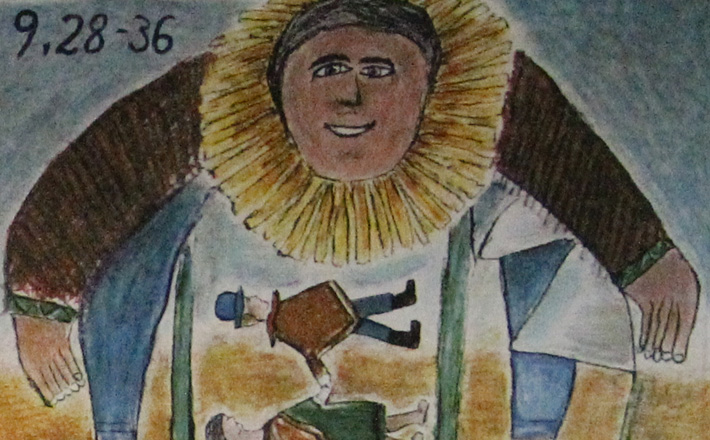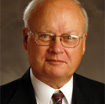Commentary on Luke 9:28-36 [37-43]
In preparation for the Transfiguration of Our Lord in Year C, one has to make an obvious decision.
Should the preacher make use of the short text, relating the Transfiguration alone (9:28-36) or use the long text, telling not only the story of the Transfiguration but also relating the story of an exorcism (Luke 9:28-43)?
For most preachers, the decision is easy. The Transfiguration is a Christological festival in the church year, which means that the story of the Transfiguration deserves attention on its own. The longer text tends to diminish the significance of the Transfiguration.
Each of the Synoptic Gospels contains an account of the Transfiguration (Matthew 17:1-9//Mark 9:2-10 //Luke 9:28-36). No such account appears in the Gospel of John, in which one might say that Jesus is somewhat transfigured as the transcendent Son of God on earth all the way through! It is also referred to in 2 Peter 1:18. The accounts in the Gospels of Matthew and Luke are drawn from Mark’s, but there are some significant differences among them.
Luke’s account is closely related to the First Lesson, in which Moses, after being in the presence of God to receive the Ten Commandments, comes down from Mount Sinai, and “the skin of his face shone because he had been talking with God” (Exodus 34:29). This feature, which is also present in Matthew’s account (Matthew 17:2), is missing in Mark’s account, in which it is said only that Jesus was transfigured (Mark 9:2).
The story takes place “about eight days” after the Confession of Peter (9:18-20), Jesus’ first passion prediction (9:21-22), and his admonitions about following him (9:23-27). All of this provides important background, for Luke himself says that the transfiguration took place “after these sayings.”
Some of the major features of Luke’s account, over against Mark’s, are the following.
1. The event takes place “about eight days” later (9:28), rather than after six (Mark 9:2; Matt 17:1); there appears to be no particular significance for the change.
2. Jesus went up the mountain to pray (9:29), perhaps to commune with God concerning his destiny.
3. Luke does not say that Jesus was actually “transfigured” (Greek metamorphōthē), as in Mark and Matthew, but says only that his face was altered; along with the other two, however, he says that the clothing of Jesus became dazzling white.
4. All that is within Luke 9:31-33 is distinctive. It has two features that are of interest for Luke’s rendition. The first is that Luke alone provides the content of the conversation between Jesus, Moses, and Elijah (on which comment is made below). The second feature is that the disciples are said to have dozed off during that conversation, but saw the glorified Jesus and the two men with him (9:32). English versions of the Bible vary widely in how they translate that verse. A rather literal translation would be that the disciples “were weighed down with sleep, but when they were fully awake, they saw his glory.”
The event happens on a mountain, a place of special revelation. Both Moses and
Elijah had received revelation on mountains. Moses received the Ten Commandments on Mount Sinai (Exodus 20:1-17). Elijah fled to Mount Horeb, and there God spoke to him in “a sound of sheer silence” (1 Kings 19:12, NRSV; RSV: “a still small voice”). It is those two men who appear on the mountain with Jesus and his companions.
While it has been common to think of them as representing the law and the prophets, which is not to be discounted, there may be more important things about them in this story. They have been on mountains to receive revelation; they are expected to appear at the coming of the messianic age (see Deuteronomy 18:15 concerning Moses; Malachi 4:5 concerning Elijah); and both had been taken into heaven and thereby were privileged to know God face-to-face and to know his will.
The story of Elijah’s going to heaven is told at 2 Kings 2:11-12. Accounts of Moses as having gone to heaven are not in the Old Testament itself, but in Jewish tradition (Josephus, Ant, 4.326). As persons who have been privy to the company and mind of God, they are able to provide Jesus with divine revelation.
Luke’s disclosure concerning the conversation is highly significant for his account. He says that Moses and Elijah “were speaking of his departure, which he was about to accomplish in Jerusalem” (9:31). The Greek term translated as “departure” is exodus (“exodus” in English). They speak then of Jesus’ exodus from this world through his suffering, death, and resurrection into heaven, the place where they dwell with God. That exodus can only happen in accord with what Jesus himself had predicted when he said, just prior to this story, that he must suffer, be killed, and be raised on the third day (9:22).
The three “dwellings” (9:33, NRSV; “booths” in RSV) recall those used at the Festival of Booths (or Tabernacles), an annual harvest festival. It commemorates God’s protection during the wilderness wanderings (Leviticus 23:39-43). As such the booths also symbolize a time of rest, which could be interpreted allegorically as the messianic rest.
The saying of Peter would then mean that, since the messianic age is here, the group should ‘camp out’ permanently on the mountain. But that is not to be. There is the voice from heaven, declaring that Jesus is God’s Son, recalling the same declaration at his baptism (3:22), followed by the saying that the disciples are to listen to Jesus (9:35). The story ends with the self-imposed silence (9:36), whereas in the parallels it is Jesus who commands the three disciples to be silent (Mark 9:9//Matthew 17:9).
As one prepares to preach on this text, it is important to bear in mind that the Transfiguration of Our Lord is a Christological festival, not so much an occasion for moralism (that we all have mountain top experiences, but must come down). As such, it brings to an end the first major portion of the church year. The Incarnation of Our Lord and the Transfiguration of Our Lord stand as book-ends or brackets at the beginning and end of the Christmas and Epiphany seasons.
The two festivals complement each other in striking ways. In the Incarnation, the divine partakes of the human condition. In the Transfiguration, the human shares in divine glory. In the Incarnation, the Son of God takes on human form and resides with us mortals on earth. In the Transfiguration, the earthly Jesus shares for a moment the company of two great and worthy residents of heaven, Moses and Elijah. Incarnation and Transfiguration are antiphonal. They enclose a portion of the church year that is now fast coming to an end, just before the period of Lent.
It is possible to structure a sermon in such a way that it brings the hearer upon the scene, looking around at the various persons present.
First, there are the disciples–Peter, James, and John. They are amazed at what they see. They are happy to see Jesus glorified. He had talked previously about his forthcoming suffering and death. But that is horrible, and now for at least a moment it appears that all that can be bypassed. Jesus is in glory already, and they are with him. They want to camp out with him on the mountain. That is a natural reaction. People seek inner peace, and they try all kinds of things to achieve it — anything that will promise much, but demand little.
Second, Moses and Elijah are present. They talk with Jesus. They know the mind and will of God. They speak of Jesus’ forthcoming “exodus” or “departure,” his forthcoming death and resurrection, which Jesus had spoken of before going up the mountain (9:22). They confirm that this is the will of God for him. The way of God for Jesus cannot bypass the cross.
This is at the heart of our Christian faith. Jesus has come to reveal God and redeem humanity. And the way that God has chosen to carry out his redemptive purpose is to send his Son, Jesus, to bear our sins upon himself at the cross. There the new “exodus” takes place, the new event of redemption for all the world.
Finally, there is the cloud and the voice. God speaks of Jesus as his Chosen One, for Jesus has accepted his role. Moreover, the disciples of Jesus are to listen to him. What he has said about himself and what is to happen is God’s will. What he says about discipleship is also to be heeded. All his teachings about love for God and for our fellow human beings are to be observed.
The Transfiguration of Our Lord is a day that gives those at worship a glimpse of the coming future glory of Christ on Easter. But it also reminds us that the way to Easter is through the cross. A few verses later, at 9:51, Luke writes that Jesus “set his face to go to Jerusalem,” where all that has been spoken of will take place for him. And for the worshiping congregation, Lent begins on the following Wednesday.


February 14, 2010